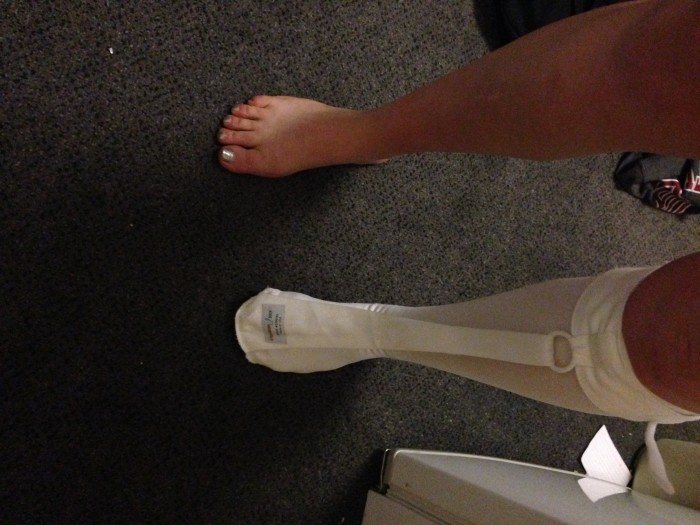Hey guys! As promised, I’m doing a “real” post today.
As most of you probably know, I’ve been dealing with plantar fasciitis for about a year now. This is a fairly common chronic injury, especially in runners, so I thought I’d go through what my experience with it is, and some ways I manage it. For those that don’t know, plantar fasciitis is inflammation of the plantar fascia, and normally appears as heel or arch pain.I’ll start by going through what I might do with it during a normal day.
Wake up. Remove my night brace. This thing is amazing and helps so much, but I can’t stand to have one on both of my feet at once. Luckily, right now one foot is much better than the other so this is fine. The brace keeps my foot flexed, which keeps everything stretched out so I don’t wake up so stiff.
If it’s bad, I might take some Advil right away, especially if I’m running. I usually don’t have to do this though. If I’m running, I stretch and then head out. I often stop to stretch my calves a little during the run. Besides making it feel a little better, I also do this because the extra stretching keeps my calves looser overall, and calf tightness can make plantar fasciitis worse.
After the run, I really should ice. I generally don’t have a ton of time to before class, but I can usually at least put in a few minutes with the frozen water bottle, which I use to roll out my heels and arches. Just a little bit of icing can go a long way in terms of pain for the rest of the day.
Then, I generally take Advil (if I haven’t already) if I want hope of being able to walk that day. The day of a run is generally the worst. Sometimes the day after is pretty bad, but by 2 days after it is pretty good.
And then in the evening, if it is sore, I’ll ice. If I’m running the next day, I’ll probably take Advil. Honestly, the pain level is WAY better when I’m taking Advil constantly, but I really don’t like to have to do that.
You’re probably seeing a theme-antinflammatories are super important!
So let’s now talk about some things to expect.
1. I don’t run back to back days, in general. If I do, I have to be pretty careful the first day of running to take really good care of my feet post-run. Another thing I’m starting to do is if I run Sunday morning, I’ll push Monday morning’s run to Monday afternoon.
2. I can’t wear any shoes. I am banned from wearing flip flops. In general, if you have plantar fasciitis, you probably need to be prepared to spend some money. Good shoes with good support is crucial. And on top of good shoes, you may need orthopedic inserts. Pretty much all my shoes at this point have some type of insert. Even the boots I just got that have pretty good general support have orthopedic inserts for extra arch support.
3. Replace running shoes often. I just replaced mine, and it made a world of difference.
4. For me, standing around a lot is a pretty surefire way to flare up the pain. While I know sitting generally isn’t good for you, I have to sit when I can.
5. For me, walking is the most painful activity. Period. Running is generally not too bad, but walking is so. awful. Especially if I’m walking somewhere after sitting in class for an hour.
6. Sometimes time off certain exercise is necessary. While this injury has still allowed me to run regularly, I did have to back out of a race and take some time completely off running.
7. It may flare up for no reason. My feet sometimes have a mind of their own, and I could do everything right and they’ll still hurt. Yayy.
8. I almost always do Crossfit in my running shoes now. I really like my Reebok Nanos, but if the workout has any significant amount of running (like more than a 400m warm up), I just can’t wear them. They have very little support, and my feet just aren’t happy with it.
9. Honestly, a chronic injury like this really stinks. It stinks to have to deal with pain on a regular basis. It stinks to be able to run one day, and barely hobble the next. But I’ve gotten pretty used to it, and I’ve learned to manage it so that running doesn’t usually hurt. It’s just unfortunate to have a chronic injury. I’m still optimistic that I can get rid of this, but it takes time and patience. I’ve started doing some exercises that I’m hoping will help, but I think it will be a while before I figure this out.
If you have any questions about plantar fasciitis-let me know and I’ll try to answer them!



